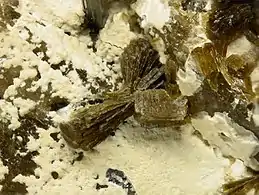Greifensteinite
Greifensteinite is beryllium phosphate mineral with formula: Ca2Fe2+5Be4(PO4)6(OH)4·6H2O. It is the Fe2+ dominant member of the roscherite group.[4] It crystallizes in the monoclinic crystal system and typically forms prismatic dark olive green crystals.[1]
| Greifensteinite | |
|---|---|
 Greifensteinite (picture size: 3 mm) | |
| General | |
| Category | Phosphate mineral Roscherite group |
| Formula (repeating unit) | Ca2Fe2+5Be4(PO4)6(OH)4·6H2O |
| Strunz classification | 8.DA.10 |
| Dana classification | 42.7.7.4 |
| Crystal system | Monoclinic |
| Crystal class | Prismatic (2/m) (same H-M symbol) |
| Space group | C2/c |
| Unit cell | a = 15.903, b = 11.885 c = 6.677 [Å]; β = 94.68°; Z = 2 |
| Identification | |
| Color | Yellow green, olive green, light brown |
| Crystal habit | Prismatic |
| Cleavage | Good on {100} (or parting on {100})[1] |
| Fracture | Uneven |
| Tenacity | brittle |
| Mohs scale hardness | 4.5 |
| Luster | Vitreous |
| Streak | White, greenish |
| Diaphaneity | Transparent to translucent |
| Specific gravity | 2.93 |
| Optical properties | Biaxial (-) |
| Refractive index | nα: 1.624 nβ: 1.634 nγ: 1.638 |
| Birefringence | 0.014 |
| 2V angle | 80° |
| References | [1][2][3] |
It was first described in Germany at Greifenstein Rocks, Ehrenfriedersdorf, and was named for the location. At the type locality, it occurs within a lithium-rich pegmatite in miarolitic cavities. It was approved by the International Mineralogical Association in 2002.[1]
References
This article is issued from Wikipedia. The text is licensed under Creative Commons - Attribution - Sharealike. Additional terms may apply for the media files.